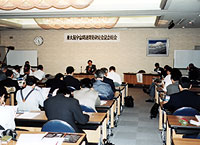|
|
|||||||
|
|
|||||||
|
|||||||
| | Web Japan >>| Trends in Japan >> | Science & Technology >> | Reaching for the Stars | |
|
REACHING FOR THE STARS Small Factories Work Together to Build Satellite (July 10, 2003)
Plenty of Technology and Skills in Town
The basic plan for building the satellite was provided by Toyohiko Aoki, the president of Aoki Co., a firm that manufactures airplane parts. With just 30 employees, it is a small company, but 10 years of hard work resulted in its being approved as a supplier for US aircraft manufacturer Boeing in 1997. Aoki, though, had grown concerned about the shrinking number of factories and the decline in the tradition of craftsmanship locally. While there were more than 10,000 factories in the area in 1983, the number had fallen to around 8,000 by 2000. Aoki was thinking of ways to give Higashi-Osaka a spark for the twenty-first century when he hit on the idea of creating a rocket. In February 2001 Aoki's factory was visited by Hisao Azuma, an astronautical engineer and professor at Osaka Prefecture University. Aoki shared with Azuma his idea of reviving the spirit of craftsmanship by building a rocket in Higashi-Osaka and asked the professor's opinion. Azuma replied that it would be too difficult for small businesses to make a rocket but that it might be possible to develop and build a satellite in Higashi-Osaka. Aoki was heartened by this advice, and the plan began to take shape. Aoki sought out collaborators and received assistance from the local chamber of commerce and industry, which set up a space-related research group. In the end, some 40 small businesses joined together, and the six companies that would do the bulk of the work formed a cooperative.
Experts Provide Assistance Many of the factories located in Higashi-Osaka are the only or the leading maker of a certain product, and the participating factories will be using these strengths in the satellite project. Cluster Technology Co., one of the world's most advanced nanotechnology firms, is responsible for the satellite's altitude-control system. Aoki Co. is the world's smallest manufacturer of parts for Boeing jumbo jets. Japan Remote Control Co., which is highly respected in the world of radio-controlled toys, will be responsible for the satellite's controls. The collective effort of these small and midsize firms to build a satellite is something that has not been attempted anywhere before. Speaking of his dreams for the future, Aoki says, "If it succeeds, this will mean more than just bringing satellite business to the area; by showing the world that the capability to produce a satellite exists in Higashi-Osaka, there is a chance that other jobs may come." While the companies involved in this project may be small, their undertaking is not. This effort demonstrates the high-level of skill and technology that many of them boast, and it is a testament to the pride these small companies take in their craftsmanship. Related Web SitesNational Space Development Agency of Japan Copyright (c) 2004 Web Japan. Edited by Japan Echo Inc. based on domestic Japanese news sources. Articles presented here are offered for reference purposes and do not necessarily represent the policy or views of the Japanese Government. |
Evolving Trends: Technology SPACE NOODLES (September 24, 2002) A HONEYMOON ON THE MOON? (April 17, 2002) SMALL BUT MIGHTY FACTORIES (January 17, 2001) |
|||||||||||||
|
||||||||||||||




